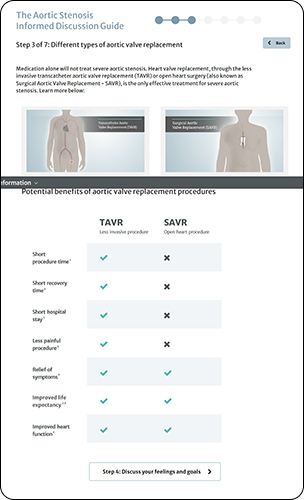Frequently Asked Questions
Have questions about aortic stenosis, also known as heart valve disease? We have answers.
Discover how to live life on your terms. Start by getting answers to your questions about diagnosis and treatment options once your heart valve disease becomes severe and you experience symptoms, which is also known as heart valve failure. Explore our frequently asked questions below and get the information you need to take control of your future.
About heart valve disease and aortic stenosis
What is heart valve disease?
Heart valve disease occurs when one or more of the four valves in your heart don’t work properly. This can cause the blood flow between your heart and your body to be disrupted and can lead to many health problems. There are many types of heart valve disease, including the most common among elderly patients—aortic stenosis.
What is aortic stenosis?
Aortic stenosis is a progressive condition caused by a narrowing of the aortic valve, which prevents normal blood flow. Because the condition will get worse with time, doctors will measure it as mild, moderate, or severe (depending on how damaged the valve is). The condition affects 1 in 8 people over the age of 75.1
What causes aortic stenosis?
There are four main causes of aortic stenosis: calcium build-up on the valve leaflets, birth defects that may impact the structure of the aortic valve, rheumatic fever which can cause scar tissue to form in the heart, and radiation therapy.
What is severe aortic stenosis?
If aortic stenosis goes untreated, it will progress to the severe stages of the disease. Severe aortic stenosis means the aortic valve has a severe build-up of calcium and struggles to open and close. Your heart may need to work harder to pump blood throughout your body.
What is severe symptomatic aortic stenosis?
Once aortic stenosis progresses to the severe stages, symptoms such as shortness of breath, chest pain, fatigue, or lightheadedness may occur.2 It is important to tell your doctor right away if you experience symptoms or if your symptoms worsen.
What are the symptoms of severe aortic stenosis?
Symptoms of severe aortic stenosis include shortness of breath, chest pain, fatigue, lightheadedness, rapid or irregular heartbeat, swollen ankles/feet or difficulty exercising.2 These symptoms may indicate your aortic stenosis has progressed to a life-threatening point.
How serious is severe aortic stenosis (also known as severe aortic valve stenosis)?
Approximately 50 percent of people who develop severe aortic stenosis symptoms will die within an average of two years if they do not have their aortic valve replaced.3 If you have been diagnosed with severe aortic stenosis or have symptoms, talk to your doctor right away about your treatment options.
Diagnosis and treatment of aortic stenosis
How is aortic stenosis diagnosed?
Your doctor will perform a few tests to determine if you have aortic stenosis. This is primarily done by listening to the sounds of your heart with a stethoscope. Diagnosis may also be done through a test called an echocardiogram, which uses ultrasound waves to obtain images of the heart chambers and valves.
What are the treatment options for aortic stenosis?
Depending on how far your aortic stenosis has progressed, your doctor may prescribe medication to help control your symptoms. However, it’s important to know the only effective way to treat aortic stenosis is by replacing your valve. This can be done through transcatheter aortic valve implantation (TAVI) or open heart surgery.
Getting a treatment evaluation
What is a Heart Team?
You may have heard the term Heart Team while researching your aortic stenosis treatment options. A Heart Team is a specialised care team that includes interventional cardiologists, cardiothoracic surgeons, imaging specialists, anesthesiologists, cardiac cath lab staff, and a cardiologist. Together, the specialised Heart Team will conduct a comprehensive evaluation to determine which procedure is appropriate for you.
What is the process for a treatment evaluation?
Once you are referred to a Heart Centre, make sure you are evaluated for all of your treatment options – including both TAVI and open heart surgery.
What tests will my doctor perform to determine which treatment is right for me?
Your doctor may use one or more of these tests to determine the best option for you.
- Chest X-ray: A type of imaging to view images of the organs and structures inside your chest. You will be placed between a metal plate and the X-ray machine. The X-ray technician will take several images of your chest in a variety of positions. This may take up to 30 minutes to perform.
- Transthoracic echochardiogram (TTE): This diagnostic test (also known as an echo) uses ultrasound to obtain 3D images of the heart. While you are lying on a table, a probe will be placed on your chest wall and will use sound waves to provide detailed pictures of your heart. This usually takes 30-60 minutes.
- Magnetic resonance imaging (MRI): A diagnostic test that uses magnetic and radio waves to take detailed pictures of your heart. You will be asked to lie down on a bed that moves into a large tube. You won’t feel anything but will hear a noise as the images are acquired. You will be asked to lie very still for duration of test. This usually takes 30-90 minutes.
- Pulmonary function test (PFT): A group of tests, using special breathing equipment, that will measure how well your lungs are moving oxygen to the blood. These can take 60-120 minutes.
- Computerized tomography (CT) scan: An imaging test that uses X-rays to obtain detailed pictures of your heart and blood vessels. You will be injected with contrast dye through an IV. You will be asked to lie down on a bed that passes through a donut-shaped X-ray scanner to take clear images of your heart. This takes up to 60 minutes.
- Angiogram (cardiac cath): An imaging test that uses X-ray and dye to see how blood flows through your arteries and veins. You will lie on your back on an X-ray table. A small incision will be made and a small tube, called a catheter, will be inserted either in your groin or near your elbow. Dye will be injected into the vessel to make the area show clearly on the X-ray pictures. This takes up to 60 minutes.
- Transesophageal echocardiogram: A test that obtains detailed pictures of your heart by inserting a probe down the esophagus (throat). While lying on a table, a technician will spray your throat with medicine to numb and supress your gag reflex. A thin flexible tube will be guided down your throat. The probe will send and receive sound waves which will become pictures on a video screen. This may take up to 60 minutes.
How long is the TAVI procedure?
Depending on your health and the procedural approach recommended by your doctor, the average TAVI procedure lasts approximately 1.5 hours.4
How long does a transcatheter heart valve last?
How long your transcatheter heart valve will last depends on many factors and will vary per person. However, regular follow-ups will help your doctor know how your valve is working.
What is TAVR, and is it different from TAVI?
TAVR stands for transcatheter aortic valve replacement. The procedure and its approaches are the same as TAVI. Your doctor may use the terms interchangeably when discussing your treatment options.
How long have TAVI procedures been performed?
TAVI has been commercially available in Australia since 2013.
What are the potential risks or complications of TAVI?
Serious complications, sometimes leading to death, may be associated with TAVI. Other risks include stroke, vascular complications and a life-threatening bleeding event. Any medical procedure carries risks. You should obtain advice from your doctor as to your condition and appropriate treatment options. Before proceeding, you should seek an evaluation from an appropriately qualified health practitioner on a Heart Team.
What should I expect directly after my TAVI procedure?
Typically following a TAVI procedure, you may be taken to the intensive care unit (ICU) for a little while or moved directly to a recovery room. Your doctor will update your caregiver or loved ones on how you are doing.
About transcatheter aortic valve implantation (TAVI)
What is TAVI (transcatheter aortic valve implantation)?
TAVI (also known as transcatheter aortic valve replacement or TAVR for short) is an alternative for replacing the aortic valve that does not require open heart surgery. During the procedure, your doctor will use a catheter to implant a new valve within your stenosed valve. TAVI can be performed through multiple approaches, however, the most common is through a small incision in the leg.
What are the different approaches used to perform TAVI?
TAVI can be performed in different ways depending on each individual’s anatomy.
- The transfemoral approach is the most common approach and is through an incision in the leg.
- The transapical approach is through an incision in the chest between the ribs.
- The transaortic approach is through an incision in the upper chest.
How long is the TAVI procedure?
Depending on your health and the procedural approach recommended by your doctor, the average TAVI procedure lasts approximately 1.5 hours.4
How long does a transcatheter heart valve last?
How long your transcatheter heart valve will last depends on many factors and will vary per person. However, regular follow-ups will help your doctor know how your valve is working.
What is TAVR, and is it different from TAVI?
TAVR stands for transcatheter aortic valve replacement. The procedure and its approaches are the same as TAVI. Your doctor may use the terms interchangeably when discussing your treatment options.
How long have TAVI procedures been performed?
TAVI has been commercially available in Australia since 2013.
What are the potential risks or complications of TAVI?
Serious complications, sometimes leading to death, may be associated with TAVI. Other risks include stroke, vascular complications and a life-threatening bleeding event.
Any medical procedure carries risks. You should obtain advice from your doctor as to your condition and appropriate treatment options. Before proceeding, you should seek an evaluation from an appropriately qualified health practitioner on a Heart Team.
What should I expect directly after my TAVI procedure?
Typically following a TAVI procedure, you may be taken to the intensive care unit (ICU) for a little while or moved directly to a recovery room. Your doctor will update your caregiver or loved ones on how you are doing.
About open heart surgery
What is open heart surgery?
Open heart surgery, or surgical aortic valve replacement (SAVR), is a treatment option for severe aortic stenosis. The diseased aortic valve is removed through an incision in the chest and requires a patient be placed on a heart and lung blood machine while under general anaesthesia.
How is open heart surgery performed?
Typically, during open heart surgery, the surgeon will make an incision across the full length of your chest to access your valve. Sometimes open heart surgeries can be performed through smaller incisions (called minimal incision valve surgery). Your old aortic valve will be taken out and a new one will be placed in your body.
How long does open heart surgery take?
The average open heart surgery lasts approximately 4 hours.4
How long does it take to recover from open heart surgery?
After open heart surgery, it can take the body a long time to recover. Your chest that needed to be opened during the operation takes several months to heal completely. Cardiac care rehabilitation is recommended to help with this recovery process. Rehabilitation after heart valve surgery usually takes three to four weeks.
What are the potential risks or complications of open heart surgery?
Serious complications, sometimes leading to re-operation or death, may be associated with open heart surgery. Other risks include stroke, infection, bleeding, abnormal heart rhythms, heart attack, kidney problems, etc. Any medical procedure carries risks. You should obtain advice from your doctor as to your condition and appropriate treatment options. Before proceeding, you should seek an evaluation from an appropriately qualified health practitioner on a Heart Team.
Patient resources for aortic stenosis and treatment options
Are there resources available to better understand aortic stenosis and treatment options?
In addition to information and advice from your doctor, there are many free patient resources available to learn more about aortic stenosis and treatment options, including patient stories, procedure videos, and brochures.
Recovery from TAVI
What should I expect directly after my TAVI procedure?
Often with TAVI, there is less downtime. Typically following a TAVI procedure, you may be taken to the intensive care unit (ICU) for a little while or moved directly to a recovery room. Your doctor will update your caregiver or loved ones on how you are doing.
How long will I be in the hospital for my TAVI procedure?
With TAVI, most patients return home the next day and have a shorter recovery time, getting them back to everyday activities.
What does life after TAVI look like?
Research has shown patient health improvements within 30 days, including the ability to take care of themselves and participate in everyday activities.3
How long does a transcatheter heart valve last?
How long your tissue valve will last depends on many patient factors and medical conditions. Follow all care instructions to ensure the best possible results. The Edwards transcatheter valve has been tested in a laboratory to mimic 5 years of use without failure. Regular follow-ups will help your doctor know how your valve is working.
What happens if my transcatheter heart valve fails?
Every year after TAVI you should have a follow-up appointment with your cardiologist, who will be checking your heart. During these visits, your cardiologist will likely perform an echocardiogram and complete other tests to make sure your valve and heart are still working properly. If your cardiologist determines that your valve is no longer working the way it should, your doctor will determine next steps and decide if you need an evaluation for reintervention. If it is determined that another procedure is needed to fix your failing heart valve, and you have previously had a transcatheter heart valve for your severe symptomatic aortic stenosis (heart valve failure), you could be eligible to get another transcatheter heart valve placed into your failed artificial valve. This procedure is known as valve-in-valve and may be an option for patients who are deemed high risk for open heart surgery.
References
1. Nikomo VT, Gardin JM, Skelton TN et al. Burden of valvular heart diseases: a population–based study. Lancet 2006;368:1005–11.
2. Mayo Clinic Staff. www.mayoclinic.com http://www.mayoclinic.org/diseases-conditions/대동맥-협착증/basics/symptoms/con-20026329. Accessed August 12, 2016.
3. Ross J Jr, Braunwald E. Aortic stenosis. Circulation 1968;38:61–7.
4. Smith, Craig R. (2016, April 2). Transcatheter or Surgical Aortic Valve Replacement in Intermediate Risk Patients with Aortic Stenosis: Final Results from the PARTNER 2A Trial; ACC 2016.








 Australia
Australia
 Brazil
Brazil
 Canada - French
Canada - French
 China - Taiwan
China - Taiwan
 Denmark
Denmark
 Finland
Finland
 Germany
Germany
 Italy
Italy
 Netherlands
Netherlands
 New Zealand
New Zealand
 Norway
Norway
 South Korea
South Korea
 Southeast Asia
Southeast Asia
 Sweden
Sweden
 United Kingdom
United Kingdom
 United States
United States